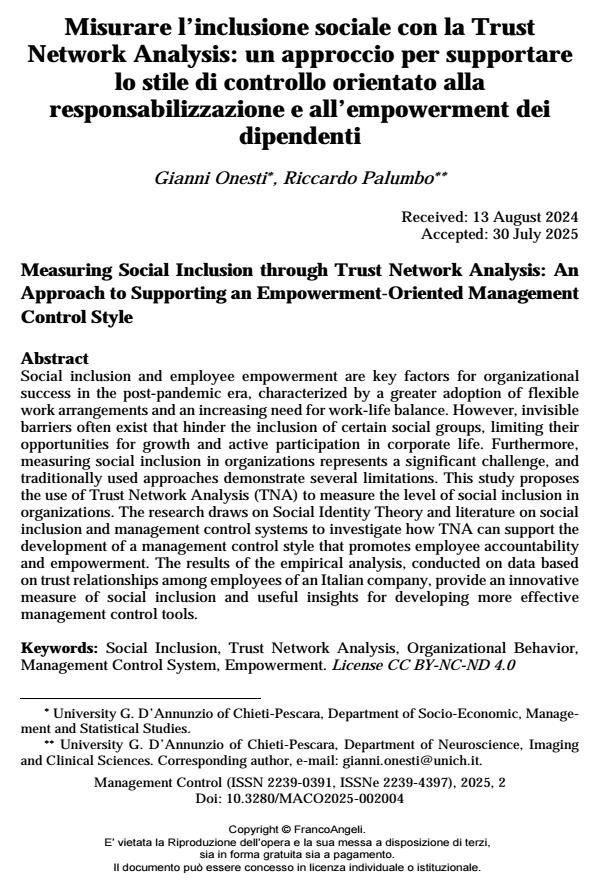Misurare l’inclusione sociale con la Trust Network Analysis: un approccio per supportare lo stile di controllo orientato alla responsabilizzazione e all’empowerment dei dipendenti
Titolo Rivista MANAGEMENT CONTROL
Autori/Curatori Gianni Onesti, Riccardo Palumbo
Anno di pubblicazione 2025 Fascicolo 2025/2
Lingua Italiano Numero pagine 24 P. 61-84 Dimensione file 208 KB
DOI 10.3280/MACO2025-002004
Il DOI è il codice a barre della proprietà intellettuale: per saperne di più
clicca qui
Qui sotto puoi vedere in anteprima la prima pagina di questo articolo.
Se questo articolo ti interessa, lo puoi acquistare (e scaricare in formato pdf) seguendo le facili indicazioni per acquistare il download credit. Acquista Download Credits per scaricare questo Articolo in formato PDF

FrancoAngeli è membro della Publishers International Linking Association, Inc (PILA)associazione indipendente e non profit per facilitare (attraverso i servizi tecnologici implementati da CrossRef.org) l’accesso degli studiosi ai contenuti digitali nelle pubblicazioni professionali e scientifiche
Social inclusion and employee empowerment are key factors for organizational success in the post-pandemic era, characterized by a greater adoption of flexible work arrangements and an increasing need for work-life balance. However, invisible barriers often exist that hinder the inclusion of certain social groups, limiting their opportunities for growth and active participation in corporate life. Furthermore, measuring social inclusion in organizations represents a significant challenge, and traditionally used approaches demonstrate several limitations. This study proposes the use of Trust Network Analysis (TNA) to measure the level of social inclusion in organizations. The research draws on Social Identity Theory and literature on social inclusion and management control systems to investigate how TNA can support the development of a management control style that promotes employee accountability and empowerment. The results of the empirical analysis, conducted on data based on trust relationships among employees of an Italian company, provide an innovative measure of social inclusion and useful insights for developing more effective management control tools.
Parole chiave:Social Inclusion, Trust Network Analysis, Organizational Behavior, Management Control System, Empowerment. License CC BY-NC-ND 4.0
Gianni Onesti, Riccardo Palumbo, Misurare l’inclusione sociale con la Trust Network Analysis: un approccio per supportare lo stile di controllo orientato alla responsabilizzazione e all’empowerment dei dipendenti in "MANAGEMENT CONTROL" 2/2025, pp 61-84, DOI: 10.3280/MACO2025-002004